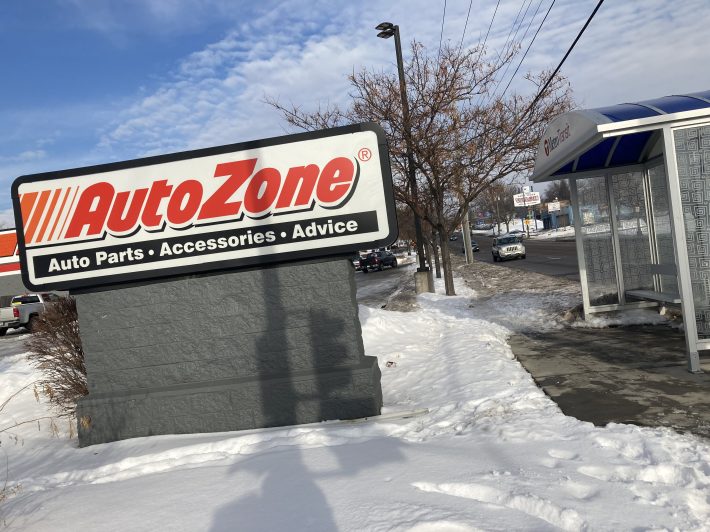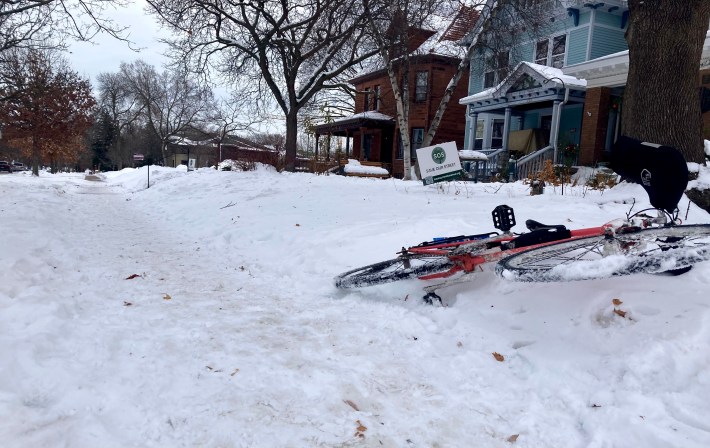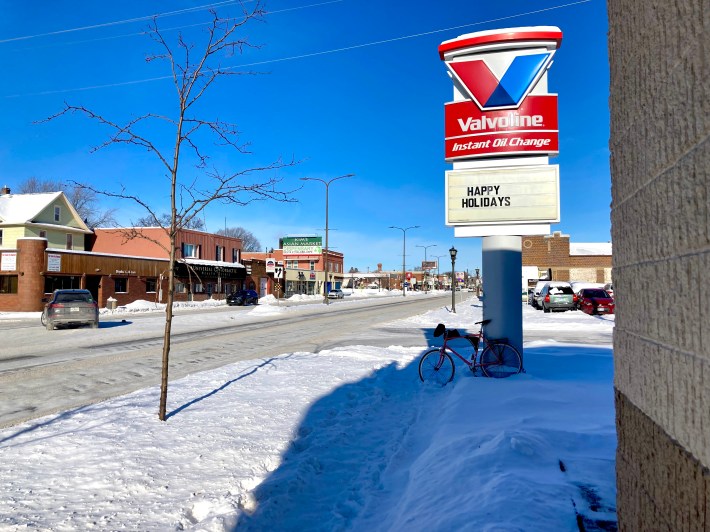Every day, thousands of people in St. Paul walk to the corner store, push strollers to daycare, walk dogs around the block, or roll on a wheelchair to the bus stop. And yet, for about five months of the year, we make these journeys dangerous and difficult by failing to keep the city’s sidewalks, trails, and crossings free of snow.
We go to great lengths to keep car infrastructure clear. Thousands of miles of the city’s highways, streets, alleys, and parking lots are quickly plowed by crews working for state, county, city, and private contractors after every snowfall. But sidewalks are at the mercy of each and every individual homeowner, business, church, and school.
Making matters worse, plows clearing streets for cars leave behind huge snow banks for pedestrians to summit, often burying freshly plowed sidewalks in chunks of icy windrow. And critical connections like pedestrian bridges often aren’t cleared for hours or even days after roads are plowed. Unshoveled walkways are utterly impassable to wheelchair users or anyone with mobility issues. And, after a few days of neglect, they become a rutted moonscape of packed ice, hazardous to even the most capable able-bodied walkers.
As a result, walking in the winter is treacherous at best. Just one homeowner laid up with the flu or on vacation creates a barrier for an entire block. Just one business that refuses to shovel forces kids walking to school onto icy streets next to speeding cars.
“Sidewalks are the capillaries of the city’s transportation system,” says Sean Kershaw, director of Saint Paul Public Works. “They’re critically important.”
Improving sidewalk shoveling throughout the city is one of Kershaw’s main goals in his tenure as director. Under his watch, he says the city has stepped up its own sidewalk clearing efforts—for example, committing to clearing 20+ new miles of trails. But public works can only do so much when homeowners and businesses fail to uphold their part of the social contract.

A perfect illustration of the problem is the AutoZone car parts store at 1515 Rice St., which has repeatedly failed to clear the sidewalks of its corner lot, leaving the bus stop there all but inaccessible.
North End resident Ethan Osten tweeted in 2021, “I have never once seen this AutoZone clear their sidewalks. I've reported them to the city several times, and even gone inside to ask the employees about it.” Nothing seems to change.
Two winters later, AutoZone still isn’t shoveling, and bus riders are forced to walk in the street to reach their stop. What can be done when there’s dozens of similarly negligent property owners all over the city?

Consider the vacant lot on the corner of University Avenue and Hamline Avenue, directly across from the Hamline Green Line Station. Not only are the lot’s sidewalks unshoveled after a recent snowfall, but a crew clearing a neighboring property banked all their snow right onto the sidewalk. Again, neighbors trying to reach the Green Line have no choice but to walk in the street. Neighbors are complaining on social media and to the city, to no avail.
Wes Burdine, owner of the nearby bar Black Hart of Saint Paul, tweeted that this snow pile has been blocking the sidewalk for more than a month, to which @squishedtoad replied that, after seeing someone in the street trying to reach the light rail stop in a wheelchair, “I've reported it 4 times now. When I called last week they said an inspector should be out end of this week.”
Added @ScoopsStP:
I called this one in to DSI one day, but it started snowing 12 hours later. Follow up call said "we've received other calls but have to wait until 24 hr after snow ends"
— ✨🚲❄️ scoops tires of scooping ❄️🚲✨ (@ScoopsStP) January 4, 2023
These issues aren’t unique to St. Paul. In Minneapolis, urbanists and disability rights advocates are urging the city to implement municipal sidewalk plowing to ensure that every sidewalk on every block is properly cleared after every snowfall. But, on this side of the river, the idea of municipal plowing has a lot less traction.

In part, this is because St. Paul historically has had a more communitarian culture. We tend to rely more on neighbors and community organizations rather than institutions to meet collective needs, even for infrastructure.
The city only recently implemented a quasi-municipal citywide garbage collection system in 2018, decades behind Minneapolis. And we still require neighbors to self-organize alley plowing contracts with private contractors, a truly dysfunctional exercise in group work where, if you’re lucky, one overachieving neighbor will get the job done for the whole block.
If you’re not lucky? Well, you can either hire a contractor yourself or forget about your alley until April.

On top of that, St. Paul’s tax base is a lot smaller than Minneapolis's. And, earlier this year, the city lost one of its key funding sources for public works when a court killed street maintenance assessments. As a result, even though residents face a 15% property tax increase, we can still barely afford to fix potholes or repaint faded bike lane markings. Adding municipal sidewalk plowing to the budget feels very much like a non-starter.
But something needs to be done. Three years ago, Midway resident Heather Worthington asked herself, “We put these damn sidewalks in, why the hell aren’t we maintaining them?” For her, a big part of the answer is for everyone to get to know their neighbors and figure out how to help. “Stop complaining, and start shoveling,” she says.
Worthington founded the Saintly City Snow Angels via the Hamline Midway neighborhood Facebook page. This year, she’s expanded the effort citywide with a mission to connect neighbors in need with volunteers willing to dig snow for the common good. For anyone in the city struggling to shovel their sidewalks, her goal is simple: “If you ask for help, I want to get you help.” Whether they’re sick, out of town, or overwhelmed by a heavy snowfall, residents are encouraged to post a request for aid. Membership in the group has surged from about 150 last year to nearly 900 today.

Worthington, who has extensive experience in city and county government, believes that neighbors helping neighbors is the best way to keep residential sidewalks clear while building vital community connections. So far, Snow Angels volunteers have helped shovel hundreds of homes for people in need. But, when it comes to scofflaw businesses, “Complaints just aren’t driving toward good outcomes.” For some businesses, no amount of fines or shame seems to make a difference. “We live in post-shame society,” Worthington says.
“There’s no reason why the current regulations shouldn’t be where we start,” says Kershaw. Property owners are required to clear their sidewalks within 24 hours of a snowfall. But the consequences for failing to do so depend on citizen complaints, which trigger a process of warning letters and inspections. In the winter of 2018, the city received 7,000 such complaints, and about 80% were fixed by the property owner by the time the city inspector arrived.
In about 20% of cases, city crews clear the sidewalk, and the property owner is fined about $280 to cover the costs. The process is slow, however, and takes at best five business days to complete. By then, it’ll likely have snowed again, and the process usually won’t start up once more until a new complaint is received. It seems some businesses have figured out that it’s cheaper and easier to pay an occasional fine than it is to pay someone to shovel.

Perhaps the city needs to proactively identify problem properties, especially along transit routes, and inspect them immediately after each snowfall. A business behaving like AutoZone, for example, should be fined each and every time it snows. After repeated violations, the city could clear the snow immediately and bill the property owner for its services.
Worthington suggests that the answer might be to create special service districts for sidewalk snow removal funded by special property tax assessments along key transit routes like University, Rice, and Snelling Avenues. Her message to property owners on transit corridors: “If you don’t want a special service district, then you need to step up [and shovel your sidewalks].”
The city already plows hundreds of miles of trails and sidewalks along park property, city bridges, and schools. For the most part, it does a pretty great job. “The city works their ass off,” Worthington says. “They’ve really stepped up.” Special service districts would allow the city to coordinate street and sidewalk plowing to minimize repetitive work and keep curb cuts and crossings clear.
The city has already dramatically improved walkability with its growing network of bicycle trails along streets like Como Avenue, Wheelock Parkway, Johnson Parkway, Ayd Mill Road, and Mounds Boulevard. Even if the adjacent sidewalks aren’t clear, the bike trails are very well maintained all winter long and pedestrians make frequent use of them.
But even if the city clears all of its properties perfectly, they’re not the only government entity responsible for clearing pedestrian infrastructure. MnDOT also has a huge job to do, which it consistently deprioritizes far below its efforts to clear roads and freeways. “MnDOT doesn’t think of their service area as having people in it,” Worthington says. Their funding, equipment, and leadership are all focused on moving cars at maximum efficiency. “Getting them to look through a different lens is a challenge.”

For example, on Thursday, December 22, the morning after our pre-Christmas snowstorm, St. Paul Parks had already cleared the sidewalk on Griggs Street along the new Midway Peace Park just north of I-94. Directly across the freeway, Parks had also cleared its trails though Dunning Field. But MnDOT’s pedestrian bridge, which lies directly in between, remained buried in snow.

Four days later, MnDOT’s multi-use trail on the I-35E bridge was still buried in snow, much of it plowed onto the path from the bridge’s car lanes. Bizarrely, St. Paul Parks had already plowed its trails all the way up to the bridge itself on the east bank of the river and Dakota County had plowed its trail on the west bank, leaving a huge snow pile completely blocking the bridge. Government entities responsible for this important river crossing aren’t coordinating.
Snelling over the railroad bridge, pic.twitter.com/E4dKenhWn2
— Dr. Lynn A. Blewett, MA, PhD (@LynnBlewett) December 23, 2022
These types of issues seem to recur on MnDOT’s sidewalks throughout the city. In the Midway, MnDOT’s practice is to clear Snelling Avenue’s sidewalks north of Hewitt Avenue only to fill them again with massive frozen ice boulders when their street plows make a second pass on the roadway.
In many cases, it seems like MnDOT just needs to get out of the way and pay the city to clear its sidewalks and trails. “If we didn’t have so many overlapping jurisdictions,” says Worthington, “this wouldn’t be such an issue.”
As it is, even knowing who to complain to is nearly impossible. Many residents might not know which trails and sidewalks belong to MnDOT and which belong to the city or county. “You shouldn’t have to be a road engineer in order to know how to complain properly,” says Kershaw. Even if the city gets blamed for other agency’s problems, he’d prefer that citizens contact the city so that they can reach out to the right entity and hopefully learn to close gaps and improve service citywide.
For now, both Kershaw and Worthington see efforts like the Saintly City Snow Angels as the way forward. Worthington hopes the city will help strengthen the initiative by providing resources to build an interactive map of properties needing help. Or refer residents with unshoveled walks to the Snow Angels group and encouraging them to ask for help.
What’s really needed is a cultural change throughout the city that prioritizes and even celebrates sidewalk clearing. We could, for example, create a Golden Shovel award to be given to residents who helped clear snow for neighbors in need. We could deliver a new snow shovel to every new homeowner with the message, “Here’s your key to the city.”
We should ask parking enforcement officers, tax assessors, and building inspectors to report unshoveled sidewalks to help expedite remediation. Or, the mayor could visit problem properties and launch a PR campaign to make St. Paul “The Most Winter Walkable City in America.” We could do so much more if we just started to take sidewalks seriously as a critical part of our city’s transportation infrastructure.
“We all have a part to play,” says Worthington. “The city is not just the government, it’s the people who live there. Sometimes we just need to step up and grab a shovel."







